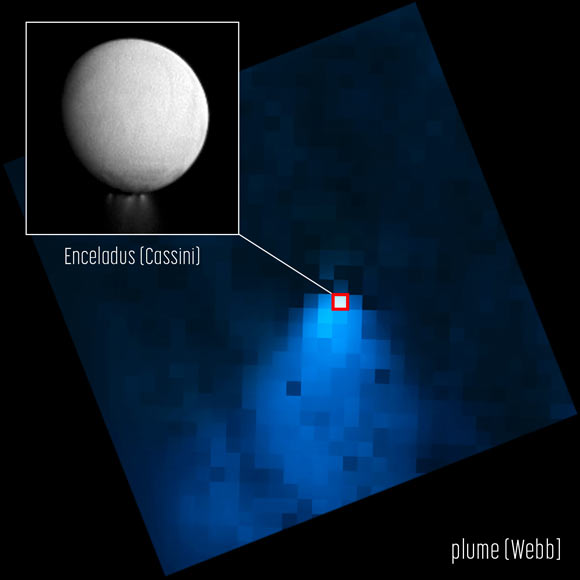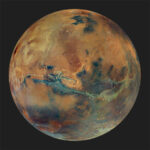As Enceladus orbits rapidly around Saturn with a period of only 1.37 Earth days, the ejected water vapor is spread along and around its orbit, forming a large torus around the gas giant.
Images from Webb’s Near-Infrared Camera (NIRCam) show a water vapor plume jetting from the south pole of Saturn’s moon Enceladus. Image credit: NASA / ESA / CSA / STScI / G. Villanueva, NASA’s Goddard Space Flight Center / A. Pagan, STScI.
Enceladus is the sixth-largest moon of Saturn with a diameter of 505 km (314 miles).
Discovered in 1789 by the German-born British astronomer William Herschel, this moon is one of the most exciting scientific targets in our Solar System in the search for life beyond Earth.
Enceladus is likely the largest source of water within the Saturnian system, with water and other materials jetted into Saturn orbit by localized geological activity.
Early hints of geological activity on Enceladus were provided by NASA’s Voyager and telescopic observations in the 1980s and 1990s, finding a close association between Enceladus’ orbit and Saturn’s outermost and widest ring — the dense E-ring.
In 2005, multiple instruments onboard NASA’s Cassini spacecraft discovered a plume of gases and ice grains emerging from fissures in the south polar region of Enceladus.
A torus of water along Enceladus’ orbit was recently observed via sub-millimeter spectroscopy with ESA’s Herschel Observatory.
The Cassini measurements of the plume gas were made using mass spectrometry along specific flyby trajectories and via stellar occultation in the inner region of the plume (less than 200 km).
In contrast, the measurements of the torus were not spatially resolved, but they indicated the presence of water vapor widely throughout the Saturnian system.
While the plume’s flux of icy grains varies on multiple timescales, the variations in the vapor flux are much less well understood, together with how these affect the structure and evolution of the torus.
By analyzing the molecular emissions across large distances from Enceladus with the NASA/ESA/CSA James Webb Space Telescope, Dr. Geronimo Villanueva from NASA’s Goddard Space Flight Center and colleagues were able to map the distribution of outgassed water, compare the level of activity to that determined by Cassini measurements, and establish a direct connection of the plume to the extended cloud of material beyond the plume that likely accumulated over multiple orbits.
“When I was looking at the data, at first, I was thinking I had to be wrong. It was just so shocking to detect a water plume more than 20 times the size of the moon,” Dr. Villanueva said.
“The water plume extends — up to 10,000 km (6,000 miles) — far beyond its release region at the southern pole.”

The infographic shows a diagram of Saturn, Enceladus, and its torus at the top, the NIRCam image of Enceladus at the bottom left, and the spectra from the NIRSpec instrument at the bottom right. Image credit: NASA / ESA / CSA / STScI / L. Hustak, STScI / G. Villanueva, NASA’s Goddard Space Flight Center.
The length of the plume was not the only characteristic that intrigued researchers.
The rate at which the water vapor is gushing out, about 79 gallons per second, is also particularly impressive.
“The orbit of Enceladus around Saturn is relatively quick, just 33 hours. As it whips around Saturn, the moon and its jets are basically spitting off water, leaving a halo, almost like a donut, in its wake,” Dr. Villanueva said.
“In the Webb observations, not only was the plume huge, but there was just water absolutely everywhere.”
“This fuzzy donut of water that appeared ‘everywhere,’ described as a torus, is co-located with Saturn’s E-ring.”
The Webb observations directly demonstrate how the moon’s water vapor plumes feed the torus.
By analyzing the Webb data, the authors determined roughly 30% of the water stays within this torus, and the other 70% escapes to supply the rest of the Saturnian system of water.
“Right now, Webb provides a unique way to directly measure how water evolves and changes over time across Enceladus’ immense plume, and as we see here, we will even make new discoveries and learn more about the composition of the underlying ocean,” said Dr. Stefanie Milam, also from NASA’s Goddard Space Flight Center.
“Because of Webb’s wavelength coverage and sensitivity, and what we’ve learned from previous missions, we have an entire new window of opportunity in front of us.”
The results appear this week in the journal Nature Astronomy.
_____
G.L. Villanueva et al. 2023. JWST molecular mapping and characterization of Enceladus’ water plume feeding its torus. Nature Astronomy, in press




